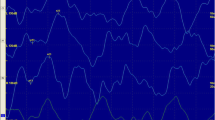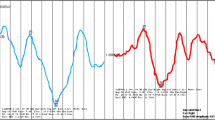Objectives. To study the parameters of vestibular evoked myogenic potentials in patients with various types of vertigo. Materials and methods. A total 77 patients (35 men, 42 women) aged 43.7 ± 12.5 years with vestibular vertigo and postural instability were studied. Surface electrode myography was used to record the activity of the sternocleidomastoid muscle arising in response to sound stimulation of the ipsilateral ear. Results and discussion. As compared with controls, patients with signs of impairment to the central compartment of the vestibular analyzer showed a tendency to an increase in the latent period of the N2 wave and a significant reduction in the amplitude of the P1–N2 complex on both sides (p < 0.005), without any significant change in the coefficient of asymmetry. Patients with signs of damage to the peripheral compartment of the vestibular analyzer showed signifi cant increases in the latent period of P1 as compared with healthy subjects (p < 0.005). In addition, there was a statistically signifi cant (p = 0.0007) increase in the coefficient of asymmetry of latent period P1. Patients with postural instability showed no significant differences in P2 and N2 latencies as compared with controls. Conclusions. The study results showed that patients with vertigo of both peripheral and central genesis have impairments to the formation of the vestibulospinal reflex at different levels of the vestibular analyzer.
Similar content being viewed by others
References
V. T. Pal’chun and N. L. Kunel’skaya, “Contemporary methods in the diagnosis of vestibular disorders,” Lecheb. Delo, 1, 53–60 (2006).
T. Lempert, “Recurrent spontaneous attacks of dizziness,” CONTINUUM: Lifelong Learning in Neurology. Neuro-Otology, 18, No. 5, 1086–1101 (2012), https://doi.org/10.1212/01.CON.0000421620.10783.ac.
M. Karatas, “Central vertigo and dizziness: epidemiology, differential diagnosis, and common causes,” Neurologist, 14, No. 6, 355–364 (2008), https://doi.org/10.1097/nrl.0b013e31817533a3.
V. Parfenov, O. Abdulina, and M. Zamergrad, “Differential diagnosis and treatment of vestibular disorders,” Nevrol. Psikhiatr. Psikhosomat., No. 2, 49 (2010), https://doi.org/10.14412/2074-2711-2010-84.
N. L. Kunel’skaya, A. L. Guseva, and E. V. Baibakova, “An efficient algorithm for the diagnosis and treatment of benign paroxysmal positional vertigo,” Vestn. Otolaringol., 80, No. 5, 19–22 (2015), https://doi.org/10.17116/otorino201580519-22.
S. V. Morozova, “Diagnosis and treatment of vertigo,” Farmateka, 7, 36–42 (2009).
V. I. Babiyak, V. G. Bazarov, and A. A. Lantsov, “Problems in vestibular pathology,” Nov. Otorinolaringol. Logopatol., 2, 67–73 (2000).
T. Brandt, M. Diterich, and M. Strupp, Vertigo and Dizziness [Russian translation], Praktika, Moscow (2009).
R. W. Baloh, V. Honrubia, Clinical Neurophysiology of the Vestibular System, Oxford University Press, New York (2001), 3rd ed., ISBN 0-195-13982-8; Clin. Neurophysiol., 432 (2001), https://doi.org/10.1016/s1388-2457(02)00126-8.
R. J. Leigt, The Neurology of Eye Movements, Oxford University Press, New York (2006), https://doi.org/10.1097/00006324-198402000-00014.
O. V. Zaitseva, “Balance impairments in peripheral vestibular syndromes: clinical aspects, diagnosis, and rehabilitation,” Lech. Vrach, 9, 90–94 (2010).
G. Zhou and L. C. Cox, “Vestibular evoked myogenic potentials: history and overview,” Am. J. Audiol., 13, No. 2, 135–143 (2004), https://doi.org/10.1044/1059-0889(2004/018).
F. Wuyts, J. Furman, R. Vanspauwen, and P. Van De Heyning, “Vestibular function testing,” Curr. Opin. Neurol., 20, No. 1, 19–24 (2007), https://doi.org/10.1097/wco.0b013e3280140808.
S. Isaradisaikul, N. Navacharoen, D. Strong, et al., “Vestibular evoked myogenic potentials,” Thai. J. Otolaryngol. Head Neck Surg., 8, No. 1, 14–20 (2007).
E. Z. Yakupov and E. A. Kuznetsova, “Diagnostic significance of vestibular evoked myogenic potentials in vestibulo-ataxic syndromes of different etiologies,” Bull. Int. Sci. Surg. Assoc., 5, No. 1 (2010).
A. S. Kudryavtseva, A. V. Amelin, S. V. Lilenko, and A. A. Skoromets, “Differential diagnosis of recurrent episodes of vertigo,” Zh. Nevrol. Psikhiatr., 116, No. 4, 4–9 (2016), https://doi.org/10.17116/jnevro2016116414-9.
G. M. Halmagyi and J. G. Colebatch, “Vestibular evoked myogenic potentials in the sternomastoid muscle are not of lateral canal origin,” Acta Otolaryngol. Suppl., 520, No. 1–3 (1995), https://doi.org/10.3109/00016489509125174.
T. Murofuschi, K. Shimizu, H. Takegoshi, and P. W. Cheng, “Diagnostic value of prolonged latencies in the vestibular evoked myogenic potential,” Arch. Otolaryngol. Head Neck Surg., 127, 1069–1072 (2001), https://doi.org/10.1001/archotol.127.9.1069.
M. S. Welgampola and J. G. Colebach, “Characteristics and clinical applications of vestibular-evoked myogenic potentials,” Neurology, 24, 64(10):1682–1688 (2005), https://doi.org/10.1212/01.wnl.0000161876.20552.aa.
C. Ferber-Viart, C. Dubreuil, and R. Duclaux, “Vestibular evoked myogenic potentials in humans: a review,” Acta Otolaryngol., 119, No. 1, 6–15 (1999), https://doi.org/10.1080/00016489950181864.
D. Basta, I. Todt, A. Eisenschenk, and A. Ernst, “Vestibular evoked myogenic potentials induced by intraoperative electrical stimulation of the human inferior vestibular nerve,” Hear. Res., 204, No. 1, 111–114 (2005), https://doi.org/10.1016/j.heares.2005.01.006.
V. V. Gnezditskii and O. S. Korepina, An Atlas of Evoked Brain Potentials (practical guidelines based on analysis of concrete clinical observations), Pressto, Ivanovo (2011).
K. Takemura and W. M. King, “Vestibulo-colic refl ex (VCR) in mice,” Exp. Brain Res., 167, No. 1, 103–107 (2005), https://doi.org/10.1007/s00221-005-0030-1.
S. A. Likhachev and N. M. Tarasevich, “Vestibular evoked myogenic potentials: anatomical-physiological aspects of their realization and clinical utilization,” Zh. Nevrol. Psikhiatr., 2, 84–89 (2011).
R. G. Bickford, J. L. Jacobson, and D. T. R. Cody, “Nature of average evoked potentials to sound and other stimuli in man,” Ann. N.Y. Acad. Sci., 112, 204–218 (2006), https://doi.org/10.1111/j.1749-6632.1964.tb26749.x.
S. Isaradisaikul, N. Navacharoen, and C. Hanprasertpong, “Cervical vestibular-evoked myogenic potentials: norms and protocols,” Int. J. Otolaryngol., 913–951 (2012), https://doi.org/10.1155/2012/913515.
I. V. Sánchez-Andrade, A. Soto-Varela, T. Labella Caballero, et al., “Impact of subject’s position and acoustic stimulus type on vestibular evoked myogenic potentials (VEMPs) in normal subjects,” Eur. Arch. Otorhinolaryngol., 271, No. 9, 2359–2364 (2014), https://doi.org/10.1007/s00405-013-2791-7.
Y. Young, C. Wu, and C. Wu, “Augmentation of vestibular evoked myogenic potentials: An indication for distended saccular hydrops,” Laryngoscope, 112, 509–512 (2002), https://doi.org/10.1097/00005537-200203000-00019.
S. D. Rauch, “Vestibular evoked myogenic potentials show altered tuning in patients with Meniere’s disease,” Otol. Neurotol., 25, 333–338 (2004), https://doi.org/10.1097/00129492-200405000-00022.
J. Venhovens, J. Meulstee, and W. Verhagen, “Vestibular evoked myogenic potentials (VEMPs) in central neurological disorders,” Clin. Neurophysiol., 127, No. 1, 40–49 (2016), https://doi.org/10.1016/j.clinph.2014.12.021.
K. Liao, “Why do patients with PSP fall? Evidence for abnormal otolith responses,” Neurology, 70, 802–809 (2008), https://doi.org/10.1212/01.wnl.0000304134.33380.1e.
K. Shimizu and T. Murofushi, “Vestibular evoked myogenic potentials in multiple sclerosis,” J Neurol. Neurosurg. Psychiatry, 69, No. 2, 276–277 (2000), https://doi.org/10.1136/jnnp.69.2.276.
C. H. Chen, and Y. H. Young, “Vestibular evoked myogenic potentials in brainstem stroke,” Laryngoscope, 113, No. 6, 990–993 (2003), https://doi.org/10.1097/00005537-200306000-00014.
S. M. Hong, S. K. Kim, C. H. Park, and J. H. Lee, “Vestibular-evoked myogenic potentials in migrainous vertigo,” Otolaryngol. Head Neck Surg., 142, No. 2, 284–287 (2011), https://doi.org/10.1177/0194599810391755.
M. I. Boldingh, U. Ljstad, A. Mygland, and P. Monstad, “Vestibular sensitivity in vestibular migraine: VEMPs and motion sickness susceptibility,” Cephalalgia, 31. No. 11, 1209–1211 (2011), https://doi.org/10.1177/0333102411409074.
Author information
Authors and Affiliations
Corresponding author
Additional information
Translated from Zhurnal Nevrologii i Psikhiatrii imeni S. S. Korsakova, Vol. 118, No. 1, Iss. 1, pp. 13–17, January, 2018.
Rights and permissions
About this article
Cite this article
Kudryavtseva, A.S., Amelin, A.V. Diagnostic Significance of Vestibular Evoked Myogenic Potentials for Different Types of Vertigo. Neurosci Behav Physi 49, 733–737 (2019). https://doi.org/10.1007/s11055-019-00793-1
Published:
Issue Date:
DOI: https://doi.org/10.1007/s11055-019-00793-1




